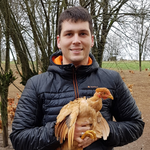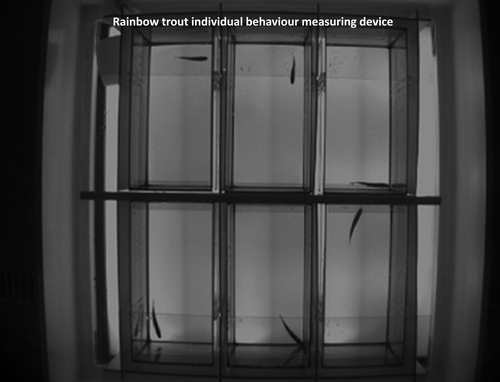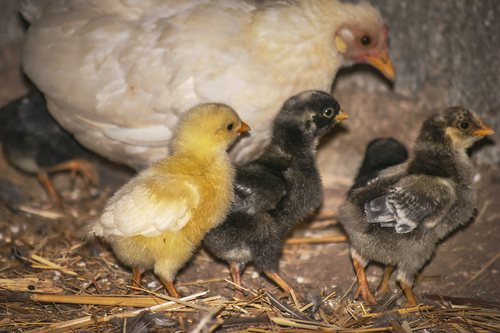
BEDERE Nicolas
- UMR PEGASE, INRAE, Saint-Gilles, France
- Animal genetics, Poultry, Precision livestock farming, Reproduction
- recommender
Recommendation: 1
Review: 1
Recommendation: 1

Screening for links between behaviour and acute hyperthermia and hypoxia resistance in rainbow trout using isogenic lines
Advancing sustainable aquaculture: behavioral insights for climate-change resilient fishes
Recommended by Nicolas Bedere based on reviews by 2 anonymous reviewersThe study by Lagarde et al. (2025) is part of efforts aiming to meet the challenges of adapting livestock farming, and more specifically of aquaculture, to the effects of climate change. In fact, during heat waves, water temperatures rise and oxygen becomes scarce. Fish have to adapt to these conditions of hyperthermia and hypoxia. Studies have already shown that it is possible to genetically improve these resistances in salmonids (e.g. Debes et al., 2021). However, current methods for phenotyping these resistances rely on exposing fish to extreme conditions until they lose equilibrium, which indicates that the animal experiences severe conditions and raises ethical and animal welfare concerns.
From the aforementioned, there is then a strong interest in using and identifying less invasive phenotypes, such as behavioural changes, that could serve as indicators of fish responses to hyperthermia and hypoxia. Some behaviours show promise in both wild (Campos et al., 2018) and farmed fish (Van Raaij et al., 1996). A former study by the authors of this manuscript suggests that some of these behaviours are sufficiently heritable to consider applying selection on them (Lagarde et al., 2023). Therefore, the main aim of the present study was to test whether behaviour can be used as an indirect selection criterion to improve the adaptation of rainbow trout to heat waves. To achieve this lofty goal, the responses of different isogenic lines of trout to hyperthermia and hypoxia were investigated using new criteria based on behavioural responses and the reference measure of loss of equilibrium.
The results suggest that certain behavioural traits, such as distance travelled and frequency of zone changes, are associated with resistance to these stresses. Moreover, moderate correlations were observed between certain behavioural variables and resistance to hyperthermia. Indeed, lines that were more resistant to hyperthermia had lower distance travelled and frequency of zone changes during the behavioural test. Other significant and positive correlations were observed between acute hypoxia resistance and certain behavioural variables, likely distance travelled, frequency of zone change and percentage of time spent moving.
These results pave the way for less invasive methods in assessing hyperthermia and hypoxia resistance based on behavioural observations, which could improve the resistance of farmed fish in response to climate change. The study further allows refining the measurements carried out on candidates for selection in order to improve their welfare during evaluation tests.
In conclusion, this study is commendable for its thematic relevance, originality and the potential application of its results to genetic selection of farmed fish.
References
Campos DF, Val AL, Almeida-Val VMF. 2018. The influence of lifestyle and swimming behavior on metabolic rate and thermal tolerance of twelve Amazon forest stream fish species. Journal of Thermal Biology 72:148–154. https://doi.org/10.1016/j.jtherbio.2018.02.002
Debes P V., Solberg MF, Matre IH, Dyrhovden L, Glover KA. 2021. Genetic variation for upper thermal tolerance diminishes within and between populations with increasing acclimation temperature in Atlantic salmon. Heredity 127:455–466. https://doi.org/10.1038/s41437-021-00469-y
Lagarde H, Phocas F, Pouil S, Goardon L, Bideau M, Guyvarc’h F, Labbé L, Dechamp N, Prchal M, Dupont-Nivet M, Lallias D. 2023. Are resistances to acute hyperthermia or hypoxia stress similar and consistent between early and late ages in rainbow trout using isogenic lines? Aquaculture 562:738800. https://doi.org/10.1016/j.aquaculture.2022.738800
Lagarde H, Lallias D, Phocas F, Goardon L, Bideau M, Guyvarc'h F, Labbé L, Dupont-Nivet M, Cousin X. 2025. Screening for links between behaviour and acute hyperthermia and hypoxia resistance in rainbow trout using isogenic lines. bioRxiv, ver.4 peer-reviewed and recommended by PCI Animal Science https://doi.org/10.1101/2023.10.19.563047
Van Raaij MTM, Pit DSS, Balm PHM, Steffens AB, Van Den Thillart GEEJM. 1996. Behavioral strategy and the physiological stress response in rainbow trout exposed to severe hypoxia. Hormones and Behavior 30:85–92. https://doi.org/10.1006/hbeh.1996.0012
Review: 1

On-farm hatching and contact with adult hen post hatch induce sex-dependent effects on performance, health and robustness in broiler chickens
The hen, the egg and the chick in conventional and on-farm hatching systems
Recommended by Florence Gondret based on reviews by Nicolas Bedere and Anna OlssonTo limit the use of antibiotics in the few days after hatching, it is necessary to improve the robustness of chicks during the early post-hatch period. This can be achieved by ensuring immediate access to feeds, optimizing the implantation and maturation of the microbiota and immune system of each chick, and minimizing exposure of stressors such as transportation. The study conducted by Guilloteau and colleagues (2024) compared the performance and health of chicks raised in conventional hatching systems with those raised in on-farm hatching systems. The authors showed that both systems yielded similar hatching percentage of eggs. Chicks from on-farm hatching systems exhibited higher body weights during the post-hatch period compared to those from conventional hatching, whereas health parameters were not affected by the system. An originality of the study was the examination of the benefits of the presence of an adult hen in hatching systems. The effects on chick traits were interpreted in relation to the hen behavior at hatching and a classification according to maternal or agonistic activities towards the chicks. However, the experimental design did not allow to make statistical correlations between hen behavior pattern and chick traits. Importantly, the presence of a hen decreased the hatching percentage, and this was likely associated with hen aggressiveness in the pen. The presence of the hen deteriorated the quality scores of the chicks in the on-farm hatching system, and increased mortality of chicks at hatching, negatively impacting chick weight gain and feed efficiency during the few days after hatching in both conventional and on-farm hatching systems. Thereafter, the effect of the presence of a hen on chick body weight was different according to the sex of the chicks and the type of hatching system. The presence of a hen did not reduce the parasitic load of the chicks nor improved clinical signs. No specific characterization of the fecal microbiota of the chicks was conducted, preventing the testing whether or not the presence of the hen affected the early implantation and maturation of the chick microbiome. Altogether, the data indicate that on-farm hatching systems are at least equivalent (in terms of health traits, feed efficiency) or even favorable (for faster growth in the early period after hatching) for chicks. Training the hens (considered as foster adults) to the presence of eggs and chicks or selecting hens according to specific activity behavioral patterns could be ways to establish better interactions between hens and chicks. Although the number and type of environmental stressors tested in the experiment differ from those in commercial farms, the article opens new perspectives for alternative hatching and farming practices.
Reference
Guilloteau LA, Bertin A, Crochet S, Bagnard C, Hondelatte A, Ravon L, Schouler C, Germain K, Collin A (2024) On-farm hatching and contact with adult hen post hatch induce sex-dependent effects on performance, health and robustness in broiler chickens. bioRxiv, 2023.05.17.541117. ver. 3 peer-reviewed and recommended by Peer Community in Animal Science. https://doi.org/10.1101/2023.05.17.541117.